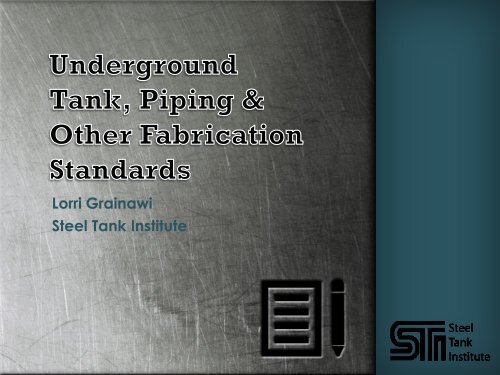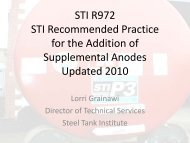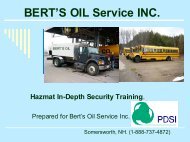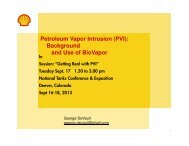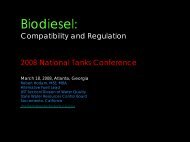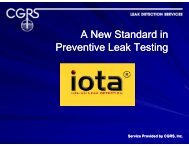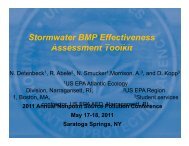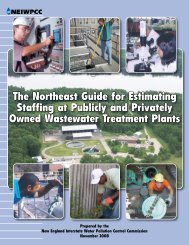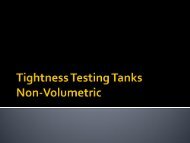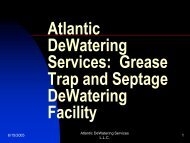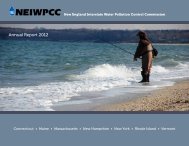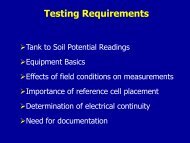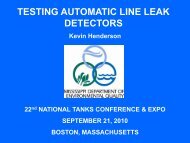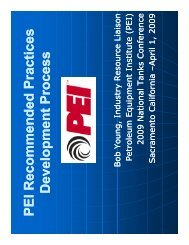Aboveground Tank Fabrication Standards - NEIWPCC
Aboveground Tank Fabrication Standards - NEIWPCC
Aboveground Tank Fabrication Standards - NEIWPCC
Create successful ePaper yourself
Turn your PDF publications into a flip-book with our unique Google optimized e-Paper software.
Lorri Grainawi<br />
Steel <strong>Tank</strong> Institute
1<br />
9<br />
8<br />
5<br />
1<br />
9<br />
9<br />
2<br />
1<br />
9<br />
6<br />
9<br />
1<br />
9<br />
8<br />
5
• UL 58 - Standard for Steel Underground<br />
<strong>Tank</strong>s for Flammable and Combustible<br />
Liquids<br />
• ULC S615 - Standard for Reinforced Plastic<br />
Underground <strong>Tank</strong>s for Flammable and<br />
Combustible Liquids<br />
• UL 1316 - Glass-Fiber-Reinforced Plastic<br />
Underground Storage <strong>Tank</strong>s for Petroleum<br />
Products, Alcohols, and Alcohol-Gasoline<br />
Mixtures
• ULC S603 - Standard for Steel<br />
Underground <strong>Tank</strong>s for Flammable And<br />
Combustible Liquids<br />
• ULC S603.1 - External Corrosion Protection<br />
Systems for Steel Underground <strong>Tank</strong>s for<br />
Flammable and Combustible Liquids<br />
• UL 1746 - Standard for External Corrosion<br />
Protection Systems For Steel Underground<br />
Storage <strong>Tank</strong>s
•UL 80 - Standard for<br />
Steel <strong>Tank</strong>s for Oil-<br />
Burner Fuel<br />
•ULC ORD-C80.1 -<br />
Non-Metallic <strong>Tank</strong>s for<br />
Fuel Oil<br />
•UL 142 - Standard for<br />
Steel <strong>Aboveground</strong><br />
<strong>Tank</strong>s for Flammable<br />
and Combustible<br />
Liquids<br />
•UL 2245 - Standard<br />
for Below-Grade<br />
Vaults for Flammable<br />
Liquid Storage <strong>Tank</strong>s<br />
•ULC S601 - Standard<br />
for Shop Fabricated<br />
Steel <strong>Aboveground</strong><br />
Horizontal <strong>Tank</strong>s<br />
• UL 2085 - Standard for<br />
Protected<br />
<strong>Aboveground</strong> <strong>Tank</strong>s<br />
for Flammable and<br />
Combustible Liquids<br />
• SwRI - Southwest<br />
Research Institute<br />
• SwRI 97-04<br />
• SwRI 93-01<br />
• API - American<br />
Petroleum Institute<br />
• API 12F<br />
• API 650, App. J
• UL 971 - Standard for Nonmetallic<br />
Underground Piping For Flammable<br />
Liquids<br />
• SU 971A - METALLIC UNDERGROUND FUEL<br />
PIPE<br />
SU means the document is an Outline of<br />
Investigation, not a Standard<br />
• ULC S660 - Standard for Nonmetallic<br />
Underground Piping for Flammable and<br />
Combustible Liquids
• SU87A - Power-Operated Dispensing<br />
Devices for Gasoline/Ethanol Blends with<br />
Ethanol Content Greater Than 15 Percent<br />
• ULC ORD-C142.19 - Spill Containment<br />
Devices for <strong>Aboveground</strong> Flammable and<br />
Combustible Liquid Storage <strong>Tank</strong>s<br />
• UL 157 - Standard for Gaskets and Seals<br />
• UL 330 - Standard for Hose and Hose<br />
Assemblies for Dispensing Flammable<br />
Liquid<br />
• UL 525 - Standard for Flame Arresters
• UL 536 - Standard for Flexible Metallic<br />
Hose<br />
• UL 860 - Pipe Unions for Flammable and<br />
Combustible Fluids and Fire-Protection<br />
Service<br />
• UL 1106 - Standard for Marine Manually<br />
Operated Shutoff Valves for Flammable<br />
Liquids
• SU 2583 - FUEL TANK ACCESSORIES<br />
• SU 2215 - OIL/WATER SEPARATORS<br />
• NLPA 631- Linings<br />
• API 1631 - Linings
• Consistent<br />
• Cover all necessary requirements<br />
• Without unnecessary restrictions<br />
• Be able to test as efficiently as possible<br />
• Clear and concise<br />
• Anyone should be able to read test,<br />
understand it and duplicate the test<br />
• Fill in the blank… ________________
• Prescriptive<br />
ULC S603, Steel Underground <strong>Tank</strong>s<br />
• Performance<br />
UL 971, Non-metallic piping<br />
• Calculation<br />
UL 58, steel thickness<br />
• All three methods should cover<br />
structural design, product<br />
compatibility and safety issues
• Steel head, or end plate thickness<br />
• Weld joints allowed<br />
• Fitting details
• Specifies weld joint<br />
designs<br />
• Air pressure shop<br />
test, 3 – 5 psi
• UL allows either a<br />
calculated approach,<br />
using formula known<br />
as “Roark” OR<br />
• Performance test, with<br />
limitations,<br />
• Roark is a conservative<br />
approach. Does not<br />
rely on backfill for<br />
support.
• Coating tests<br />
mirrored after FRP<br />
tank standard<br />
• Interstitial<br />
communication is<br />
required<br />
• Mainly<br />
performance<br />
standard, 2009<br />
ANSI approved
UL 1316<br />
ISBN 1-55989-385-0<br />
Glass-Fiber-Reinforced Plastic<br />
Underground Storage <strong>Tank</strong>s for<br />
Petroleum Products, Alcohols, and<br />
Alcohol-Gasoline Mixtures<br />
1996<br />
• Atmospheric <strong>Tank</strong><br />
• Single wall<br />
• Double wall<br />
• Does not cover<br />
heating coils or<br />
compartment tanks<br />
• Mainly<br />
performance, but<br />
• Steel fittings and<br />
venting specified
• Three tests<br />
Water load test,<br />
one hour<br />
External Pressure on<br />
buried tank<br />
Internal pressure<br />
12 External Pressure Test<br />
12.1 A tank shall be tested as<br />
described in 12.2. The tank shall not<br />
implode or otherwise be damaged.<br />
12.2 The empty tank is to be installed<br />
in a test pit using the specified<br />
anchoring system and the specified<br />
backfill procedure. The pit is then to be<br />
filled with water to such a level that<br />
the tank is submerged to its maximum<br />
specified burial depth. The tank is to<br />
remain submerged for 24 hours. While<br />
the tank is still submerged, it is to be<br />
subjected for 1 minute to a partial<br />
internal vacuum so that the internal<br />
pressure on the tank is 5.3 inches of<br />
mercury less than the external<br />
pressure imposed by the hydrostatic<br />
head.<br />
13 Internal Pressure Test<br />
A tank shall withstand without rupture<br />
for 1 minute to an internal pressure as<br />
specified:<br />
10 ft dia or less, 25 psi<br />
Greater than 10 ft, 15 psi
• Immersion Testing - 180 to 270 days<br />
Must maintain 50% of strength
• Impact and Cold Exposure<br />
16 hour conditioning<br />
1.18 lb ball<br />
• Light and water exposure<br />
180 to 360 hour exposure<br />
Must maintain 80% strength
• Comprehensive test<br />
program with 27<br />
possible tests<br />
• Interstitial<br />
communication<br />
• Puncture & crush<br />
resistance<br />
• Pressure & Vacuum<br />
• Permeation<br />
• Impact
• Product<br />
compatibility testing<br />
(100% ethanol & 100%<br />
methanol<br />
• Failure to burst<br />
• Failure modes<br />
include cracking,<br />
splitting, bulging,<br />
collapse and<br />
delamination
• Scope currently covers vapor control,<br />
emergency vents, normal vents, caps and<br />
covers<br />
• Prescriptive in that it states min/max for<br />
pipe diameters<br />
• Performance to prove protection against<br />
Rain entry<br />
Ice Blocking<br />
• Test fluids include Biodiesel &<br />
aggressive fuels
• Scope includes<br />
meters, hoses,<br />
pumps, etc.<br />
• Product<br />
compatibility<br />
testing includes<br />
aggressive fuels<br />
• Cyclic endurance<br />
testing done for<br />
moving parts
Img_0211.mov<br />
• Test fluids vary<br />
• Only one standard<br />
includes biodiesel<br />
• Two test with<br />
aggressive fluids<br />
• Steel does not<br />
require testing
UL standards cover only to the<br />
point the product leaves the<br />
factory<br />
• Interstitial<br />
communication<br />
required for three<br />
UL standards<br />
• Performance<br />
based mixed with<br />
prescriptive<br />
requirements with<br />
some calculation


